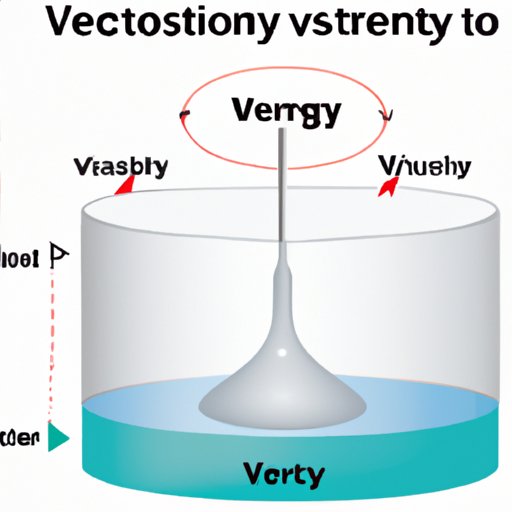Introduction
Viscosity is a fundamental physical property of a fluid or material that describes its resistance to flow. It can be thought of as a measure of the friction between particles within the fluid or material, and is often used to describe the consistency of fluids such as oil, water, and honey. In science and technology, viscosity is an important factor in understanding the behavior of fluids and materials under various conditions.

Exploring the Basics of Viscosity: A Guide to Understanding this Scientific Phenomenon
In order to fully understand what viscosity is and how it influences science and technology, we must first explore the basics of this physical property.
What is Viscosity?
Viscosity is a property of fluids and materials that describes their resistance to flow. It is often described as a measure of the internal friction between particles within the fluid or material. The higher the viscosity, the more resistant the fluid or material is to flow. For example, honey has a high viscosity and is very resistant to flow, while water has a low viscosity and flows easily.
Examples of Viscosity in Nature
Viscosity can be seen in many everyday examples. For instance, honey has a higher viscosity than water so it takes longer to pour. Moreover, motor oil has a higher viscosity than gasoline so it doesn’t flow as quickly. Additionally, lava has a very high viscosity, which is why it moves slowly and sticks to surfaces.
Factors That Affect Viscosity
There are several factors that can affect the viscosity of a fluid or material. The most common factors include temperature, pressure, and concentration. As temperature increases, viscosity typically decreases; as pressure increases, viscosity tends to increase; and as concentration increases, viscosity also increases.
How Does Viscosity Influence Science and Technology?
Viscosity plays an important role in many areas of science and technology. From physics to engineering to chemistry, viscosity can have a profound effect on the behavior of fluids and materials.
Applications of Viscosity in Physics
In physics, viscosity is used to describe the motion of fluids and gases. For example, Newton’s law of viscosity states that the force required to move two layers of fluid past each other is proportional to the viscosity of the fluid. Viscosity is also used to explain the phenomenon of turbulence, where a fluid undergoes chaotic changes in velocity.
Uses of Viscosity in Engineering
In engineering, viscosity is used to design components and systems that interact with fluids. For example, engineers use viscosity to calculate the flow rate of a pump or to determine the lubrication properties of a bearing. Furthermore, viscosity is used to optimize the performance of engines and turbines.
Benefits of Viscosity in Chemistry
In chemistry, viscosity is used to study the interactions between molecules. For example, scientists use viscosity to measure the strength of intermolecular forces, which can help them understand the behavior of different substances. Viscosity can also be used to determine the solubility of a substance in a given solvent.

The Physics of Viscosity: A Closer Look at this Physical Property
Now that we’ve explored the basics of viscosity and its importance in science and technology, let’s take a closer look at the physics of this physical property.
Newtonian Fluids and Non-Newtonian Fluids
The viscosity of a fluid can be classified as either Newtonian or non-Newtonian. Newtonian fluids, such as water and oil, follow Newton’s law of viscosity, which states that the force required to move two layers of fluid past each other is proportional to the viscosity of the fluid. Non-Newtonian fluids, such as toothpaste and paint, do not follow this law.
Viscosity Measurement Techniques
There are several techniques for measuring the viscosity of a fluid. These include rotational viscometers, falling ball viscometers, and capillary viscometers. Each technique has its own advantages and disadvantages, so it is important to choose the right one for the application.
Viscosity and Turbulence
Turbulence occurs when a fluid undergoes chaotic changes in velocity. It is caused by a combination of viscosity and the Reynolds number, which is a measure of the ratio of inertial forces to viscous forces. By understanding the physics of viscosity and turbulence, engineers can design components and systems that interact with fluids in a more efficient and effective manner.
What is Viscosity and How Does it Affect Us?
Viscosity is an important physical property that affects many aspects of our lives. Let’s take a look at how viscosity influences everyday life, industrial processes, and transportation.
Effects of Viscosity on Everyday Life
Viscosity affects many everyday activities, from driving a car to cooking dinner. For example, motor oil has a higher viscosity than gasoline so it doesn’t flow as quickly, which is why it is important to check the oil level in a car regularly. In cooking, honey has a higher viscosity than water so it takes longer to pour, which is why recipes often call for adding honey slowly.
Viscosity in Industrial Processes
Viscosity is also important in industrial processes. For instance, in the production of paper, the viscosity of the pulp must be carefully controlled in order to achieve the desired paper quality. In the manufacture of paints and coatings, viscosity is used to adjust the thickness and texture of the product. Viscosity is also used to measure the strength of adhesives.
Role of Viscosity in Transportation
Viscosity is also important in transportation. For example, the viscosity of motor oil affects the performance of an engine, while the viscosity of aircraft fuels affects the efficiency of an aircraft. The viscosity of a lubricant can also affect the fuel economy of a vehicle.
Measuring Viscosity in Different Liquids: A Comprehensive Overview
Once the viscosity of a fluid or material is known, it can be measured using various methods. Let’s take a look at some of the most common methods of viscosity measurement.
Types of Viscosity Meters
Viscosity meters come in a variety of types, including rotating spindle viscometers, falling ball viscometers, and capillary viscometers. Each type has its own advantages and disadvantages, so it is important to choose the right one for the application.
Calibrating Viscosity Meters
It is important to calibrate viscometers before use in order to ensure accurate results. Calibration involves adjusting the viscometer to the correct settings based on the fluid or material being measured. This ensures that the viscometer is giving accurate readings.
Common Methods of Viscosity Measurement
The most common methods of viscosity measurement include the kinematic viscosity method, the Saybolt Universal viscosity method, and the Brookfield viscosity method. Each method has different advantages and disadvantages, so it is important to choose the right one for the application.
Conclusion
This article explored the basics of viscosity and how it influences science and technology. We looked at the definition of viscosity, the factors that affect it, and the various applications of viscosity in physics, engineering, and chemistry. We also discussed the physics of viscosity, including Newtonian fluids and non-Newtonian fluids, and the different methods of viscosity measurement. Finally, we examined the effects of viscosity on everyday life, industrial processes, and transportation. Viscosity is an important physical property that affects many aspects of our lives, and understanding it can help us make better decisions in our day-to-day lives.
(Note: Is this article not meeting your expectations? Do you have knowledge or insights to share? Unlock new opportunities and expand your reach by joining our authors team. Click Registration to join us and share your expertise with our readers.)
